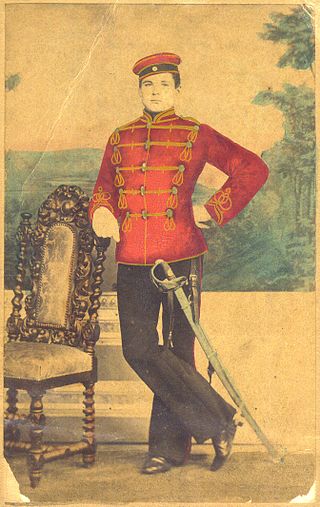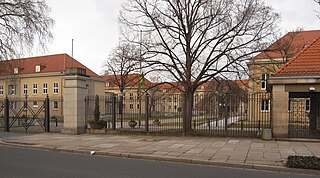Oberleutnant
Last updatedThis article needs additional citations for verification .(November 2022) |
Oberleutnant (lit. 'Upper lieutenant') is the highest lieutenant officer rank in the German-speaking armed forces of Germany (Bundeswehr), the Austrian Armed Forces, and the Swiss Armed Forces.
Contents
Occupied Austria
| | This section is empty. You can help by adding to it. (November 2022) |
Germany
| Senior lieutenant Oberleutnant | |
|---|---|
  Army and Air Force insignia | |
| Country | |
| Service branch | |
| Abbreviation | OLt |
| NATO rank code | OF-1 |
| Formation | 1871 |
| Next higher rank | Hauptmann |
| Next lower rank | Leutnant |
| Equivalent ranks | Oberleutnant zur See |
In the German Army, it dates from the early 19th century. Translated as "senior lieutenant", the rank is typically bestowed upon commissioned officers after five to six years of active-duty service.
Oberleutnant is used by both the German Army and the German Air Force. In the NATO military comparison system, a German Oberleutnant is the equivalent of a First lieutenant in the Army/Air Forces of Allied nations.
- Other uses
The equivalent naval rank is Oberleutnant zur See .
In Nazi Germany, within the SS, SA and Waffen-SS, the rank of Obersturmführer was considered the equivalent of an Oberleutnant in the German Army. [1] [2]
| Rank insignias Oberleutnant/Oberleutnant zur See (OF-1) | |||||||||
|---|---|---|---|---|---|---|---|---|---|
| | | | |||||||
| | | | | | |  | | ||
| Service uniform (basic form) (Armored corps) | Field uniform (Armored infantry) | San OA | Service uniform (basic form) | Field uniform | San OA | Shoulder strap | Sleeve insignia | Mountain loop | San OA |
National People's Army
In the GDR National People's Army (NPA) the rank was the highest lieutenant rank, until 1990. This was in reference to Soviet military doctrine and in line with other armed forces of the Warsaw pact.
The equivalent rank in the Volksmarine (en: GDR Navy) was Oberleutnant zur See. Later it was shortened to simply Oberleutnant; however, internally Oberleutnant zur See continued to be used. With reference to the Soviet armed forces and to other armed forces of the Warsaw pact Oberleutnant was the second lowest officer rank until 1990.
| Rank insignia | |||||||||
|---|---|---|---|---|---|---|---|---|---|
| | | | | ||||||
 |  | N/A |  |  |  | ||||
| Oberleutnant | Oberleutnant zur See | ||||||||
Switzerland
| | This section is empty. You can help by adding to it. (November 2022) |
See also
Related Research Articles
Oberstleutnant is a senior field officer rank in several German-speaking and Scandinavian countries, equivalent to lieutenant colonel. It is currently used by both the ground and air forces of Austria, Germany, Switzerland, Denmark, and Norway. The Swedish rank överstelöjtnant is a direct translation, as is the Finnish rank everstiluutnantti.
Leutnant is the lowest Junior officer rank in the armed forces of Germany (Bundeswehr), the Austrian Armed Forces, and the military of Switzerland.

The National People's Army were the armed forces of the German Democratic Republic (GDR) from 1956 to 1990.
This is a list of words, terms, concepts, and slogans that have been or are used by the German military. Ranks and translations of nicknames for vehicles are included. Also included are some general terms from the German language found frequently in military jargon. Some terms are from the general German cultural background, others are given to show a change that was made before or after the Nazi era. Some factories that were the primary producers of military equipment, especially tanks, are also given.
Generalmajor is the Germanic variant of major general, used in a number of Central and Northern European countries.
Generalleutnant is the Germanic variant of lieutenant general, used in some German speaking countries.
Oberleutnant zur See is traditionally the highest rank of Lieutenant in the German Navy. It is grouped as OF-1 in NATO.
Unteroffizier is a junior non-commissioned officer rank used by the Bundeswehr. It is also the collective name for all non-commissioned officers in Austria and Germany. It was formerly a rank in the Imperial Russian Army.
Army general, was the highest peacetime general officer rank in the so-called armed organs of the GDR, that is, the Ministry of National Defence, the Stasi, and the Ministry of the Interior. It is comparable to the four-star rank in many NATO armed forces. It was aligned with Soviet military doctrine and other armed forces of the Warsaw Pact.
Oberst is a senior field officer rank in several German-speaking and Scandinavian countries, equivalent to Colonel. It is currently used by both the ground and air forces of Austria, Germany, Switzerland, Denmark, and Norway. The Swedish rank överste is a direct translation, as are the Finnish rank eversti and the Icelandic rank ofursti.
Senior colonel is an officer rank usually placed between a regular colonel and a British or American brigadier general.
General is the highest rank of the German Army and German Air Force. As a four-star rank it is the equivalent to the rank of admiral in the German Navy.
Fähnrich is an officer candidate rank in the Austrian Bundesheer and German Bundeswehr. The word Fähnrich comes from an older German military title, Fahnenträger, and first became a distinct military rank in Germany on 1 January 1899. However, Fähnrich ranks are often incorrectly compared with the rank of ensign, which shares a similar etymology but is a full-fledged commissioned officer rank.
Oberstarzt (OTA) is a military rank in German speaking armed forces. It denotes a medical staff officer surgeon or medical staff officer dentist and is comparable to Colonel (de: Oberst) or Captain (naval) (de: Kapitän zur See) NATO-Rangcode OF5 in anglophone armed forces.
The ranks of the German Armed Forces,, were set up by the President with the Anordnung des Bundespräsidenten über die Dienstgradbezeichnungen und die Uniform der Soldaten on the basis of section 4, paragraph 3 of the Soldatengesetz. The Bundesbesoldungsordnung regulates the salary scales of all Federal office holders and employees including soldiers. The 'ZdV-64/10 – Abkürzungen in der Bundeswehr' gives the abbreviations and a list of the abbreviations.
Fähnrich was a military rank in the National People's Army (NPA) of the German Democratic Republic (GDR) including the GDR Volksmarine and Border troops, from 1973 to 1990. The minimum service time to this particular type of military specialist was 15 years.

Unterleutnant was an officer of the armies of East Germany and other nations. The rank was first introduced in 1662-74 by France and was also adopted by some other countries' armed forces. In the East German National People's Army from 1956 to 1990, Unterleutnant was the lowest commissioned officer (CO) rank comparable to NATO rank codes OF1c. It belonged to the rank group of lieutenants or subaltern officers. The equivalent OF1c-rank of the Volksmarine was Unterleutnant zur See.
Stabsarzt, in English Staff Surgeon, is a military commissioned officer rank in German speaking armed forces. In the German Bundeswehr and the former Wehrmacht and Reichswehr, it describes a qualified or licensed surgeon or dentist who practises military medicine, with a rank equal to captain in the army and the air force or lieutenant in the navy. In the Austrian and Swiss armies, the rank is Hauptmann.

Oberarzt, literally meaning "senior physician," in English known as first lieutenant (Dr.), was a military commissioned officer rank in the Austro-Hungarian Common Army until 1918, and in the German Reichswehr and Wehrmacht until 1945.

The Friedrich Engels Military Academy was the first military institution founded in East Germany and the highest leveled military teaching and research institution. Located in Dresden, the academy was the center of military science of East Germany.
References
- ↑ Flaherty 2004, p. 148.
- ↑ McNab 2009, p. 15.